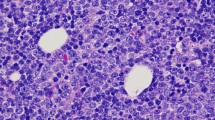Abstract
A 49-year-old woman who had previously received treatment with cytotoxic drugs for metastatic gestational trophoblastic disease (GTD) presented with a witnessed tonic–clonic seizure, headache, confusion and blindness, 6 days after the uneventful administration of a general anaesthetic and 2 months after cessation of chemotherapy. Magnetic resonance imaging showed relatively symmetrical, subcortical, white matter abnormalities, predominantly affecting the occipital, posterior temporal and parietal lobes and the cerebellum. T2-dependent abnormalities and elevated regional apparent diffusion coefficient were present in a pattern typical for posterior reversible encephalopathy syndrome (PRES). The clinical and radiological manifestations were resolved completely with supportive therapy. This case of PRES may be a late complication of gemcitabine or cisplatin therapy precipitated by a general anaesthetic, or associated electrolyte or blood pressure disturbance.

Similar content being viewed by others
References
Hinchey J, Chaves C, Appignani B, et al (1996) A reversible posterior leukoencephalopathy syndrome. N Engl J Med 334:494–500
Casey SO, Sampaio RC, Michel E, Truwit CL (2000) Posterior reversible encephalopathy syndrome: utility of fluid-attenuated inversion recovery MR imaging in the detection of cortical and subcortical lesions. AJNR Am J Neuroradiol 21:1199–1206
Ay H, Buonanno FS, Schaefer PW, et al (1998) Posterior leukoencephalopathy without severe hypertension: utility of diffusion-weighted MRI. Neurology 51:1369–1376
Russell MT, Nassif AS, Cacayorin ED, et al (2001) Gemcitabine-associated posterior reversible encephalopathy syndrome: MR imaging and MR spectroscopy findings. Magn Reson Imaging 19:129–132
Ito Y, Arahata Y, Goto Y, et al (1998) Cisplatin neurotoxicity presenting as reversible posterior leukoencephalopathy syndrome. AJNR Am J Neuroradiol 19:415–417
Schwartz RB, Mulkern RV, Gudbjartsson H, Jolesz F (1998) Diffusion-weighted MR imaging in hypertensive encephalopathy: clues to pathogenesis. AJNR Am J Neuroradiol 19:859–862
Pamela W, Schaefer MD, Ferdinand S, et al (1997) Diffusion-weighted imaging discriminates between cytotoxic and vasogenic edema in a patient with eclampsia. Stroke 28:1082–1085
Covarrubias DJ, Luetmer PH, Campeau NG (2002) Posterior reversible encephalopathy syndrome: prognostic utility of quantitative diffusion-weighted MR images. AJNR Am J Neuroradiol 23:1038–1048
Provenzale JM, Petrella JR, Cruz LC Jr, Wong JC, Engelter S, Barboriak DP (2001) Quantitative assessment of diffusion abnormalities in posterior reversible encephalopathy syndrome. AJNR Am J Neuroradiol 22:1455–1461
Port JD, Beauchamp MD Jr (1998) Reversible intracerebral pathologic entities mediated by vascular autoregulatory dysfunction. Radiographics 18:353–367
Hauser RA, Lacey DM, Knight MR (1998) Hypertensive encephalopathy. Magnetic resonance imaging demonstration of reversible cortical and white matter lesions. Arch Neurol 45:1078–1083
Jones BV, Egelhoff JC, Patterson RJ (1997) Hypertensive encephalopathy in children. AJNR Am J Neuroradiol 18:101–106
Schwartz RB, Jones KM, Kalina P, et al (1992) Hypertensive encephalopathy: findings on CT, MR imaging, and SPECT imaging in 14 cases. AJR Am J Roentgenol 159:379–383
Beausang-Linder M, Bill A (1981) Cerebral circulation in acute arterial hypertension-protective effects of sympathetic nervous activity. Acta Physiol Scand 111:193–199
Edvinsson L, Owman C, Sjoberg NO (1976) Autonomic nerves, mast cells and amine receptors in human brain vessels: a histochemical and pharmacological study. Brain Res 115:377–393
Zoja C, Furci L, Ghilarda F, Zilio P, Benigni A, Remuzzi G (1986) Cyclosporin-induced endothelial cell injury. Lab Invest 55:455–462
Haug C, Duell T, Voisard R, et al (1995) Cyclosporin A stimulates endothelin release. J Cardiovasc Pharmacol 26:239–241
Haug C, Duell T, Lenich A, Kolb HJ, Grunert A (1995) Elevated plasma endothelin concentrations in cyclosporine treated patients after bone marrow transplantation. Bone Marrow Transplant 16:191–194
Lindeman G, Kefford R, Stuart-Harris R (1990) Cisplatin neurotoxicity. N Engl J Med 323:64–65
Sugimoto S, Yamamoto YL, Nagahiro S, Diksic M (1995) Permeability change and brain tissue damage after intracarotid administration of cisplatin studied by double-tracer autoradiography in rats. J Neurooncol 24:229–240
Gregg RW, Molepo JM, Monpetit VJ, Mikael NZ, Redmond D, Gadi DJ (1992) Cisplatin neurotoxicity: the relationship between dosage, time, platinum concentration in neurologic tissues, and morphological evidence of toxicity. J Clin Oncol 10:795–803
Fischer S, Renz D, Schaper W, Karliczek GF (1995) In vitro effects of fentanyl, methohexital, and thiopental on brain endothelial permeability. Anesthesiology 82:451–458
Todd MM, Weeks J (1996) Comparative effects of propofol, pentobarbital, and isoflurane on cerebral blood flow and blood volume. J Neurosurg Anesthesiol 8:296–303
Thompson CB, June CH, Sullivan KM, Thomas ED (1984) Association between cyclosporin neurotoxicity and hypomagnesaemia. Lancet 2:1116–1120
Lanzinger MJ, Moretti EW, Wilderman RF, El-Moalem HE, Toffaletti JG, Moon RE (2003) The relationship between ionised and total serum magnesium concentrations during abdominal surgery. J Clin Anesth 15:245–249
Author information
Authors and Affiliations
Corresponding author
Rights and permissions
About this article
Cite this article
Rangi, P.S., Partridge, W.J., Newlands, E.S. et al. Posterior reversible encephalopathy syndrome: a possible late interaction between cytotoxic agents and general anaesthesia. Neuroradiology 47, 586–590 (2005). https://doi.org/10.1007/s00234-005-1376-6
Received:
Accepted:
Published:
Issue Date:
DOI: https://doi.org/10.1007/s00234-005-1376-6




